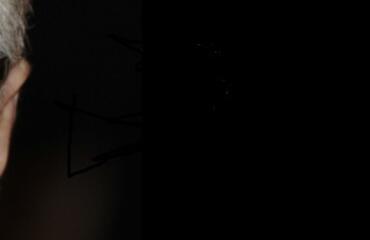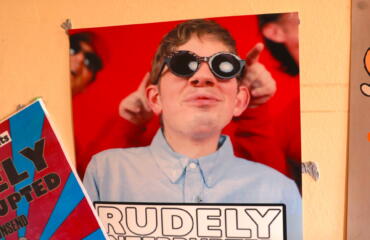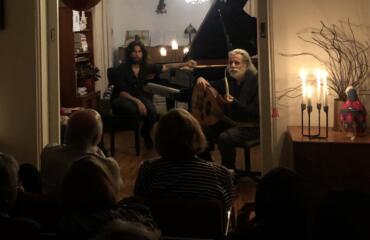
Dr Thomas Bristow helped organise the exhibition and collaborated with illustrator Elizabeth Hickey on a graphic novel. PIC: Antonia Goodfellow
A herbarium – an institution devoted to collecting plant samples – might not immediately seem like a traditional source of artistic inspiration.
But a small exhibition at Carlton Connect’s Lab-14 gallery brings together six artists who have created works inspired by the University of Melbourne’s Herbarium.
The exhibition includes works in media including photography, poetry, a graphic novel and sound.
The artists ended up responding not just to the plant material collected in the Herbarium, but to the institution itself.

“I was interested in one particular specimen collected by Joseph Banks,” said Dr Bonny Cassidy, whose poem GROUNDS is featured in the exhibition.
“I immediately realised that I was interested in the archive as a representation of colonisation, and so the Herbarium started to take on this political context which I didn’t really know about before I went in.”
Alongside Dr Thomas Bristow and Dr Jan Brueggemeier, Dr Danielle Wyatt helped co-ordinate the exhibition. She said that the artists learned a lot through the process of creating their works.
“Coming from the humanities we have an idea of art as this humanist, life-giving discourse as opposed to the cold, objective hand of science,” she said. “But what you realise about the Herbarium is that it’s a very cultural and human space.”
Dr Bristow collaborated with illustrator Elizabeth Hickey on a graphic novel for the exhibition. Among other things, their work explores the new discoveries that interdisciplinary collaboration can help facilitate.
The Herbarium itself is located on the first floor of the university’s labyrinthine Botany building. Started in 1926, it is the oldest and largest university herbarium in Australia, with around 150,000 specimens of plants and fungi filed in its stacks and shelves. Watercolours and other works of art on the subject of botany are also in the collection.
“Artists and people in the humanities want to play a role in tackling these big, social problems that previously we’ve maybe felt disciplinarily excluded from. I also think that institutions have new pressures put on them to prove their value and find new ways to extend themselves to the public.” — Danielle Wyatt, co-organiser of the exhibition
Dr Jo Birch, the Herbarium’s chief curator, notes that the social context of the plants in the collection is just as important as the plants themselves.
“We keep the field notebooks associated with the specimens, keep the numbering systems and supporting documentation, so that all these links can be made by other people,” she said.
“Once those links are lost then the objects lose that context and they have a lot less value. There are such interesting stories in there.”
The artists incorporated the Herbarium to various degrees in their work.
“Take Josh Wodak’s work,” Dr Wyatt said. “He’s interested in the collecting institution and its methods, and he translates that – it’s almost a direct translation of data – into sonic form.”
For artist Harry Nankin, the exhibition offered the chance to further his interest in the natural world’s relationship with us.
Nankin was a wilderness photographer but “gave it away in the 90s to turn to less literal interpretations of the world,” he said, “in order to reveal other things about our relationship that can’t be revealed by taking pictures of lovely places — not that I’m against that!”
To create his work In Defence of the Pathetic Fallacy,Nankin travelled to a small patch of semi-native bush south-west of Mildura. At night, he erected support systems in the bush, placed photographic film onto the structure and then let off flashes of light. Situating the bush vegetation between the flash and film, he captured a shadow of vegetation, imprinted at full scale onto film.
The Herbarium sample of the plant he captured on film – the Belah tree, or Casuarina pauper– is also exhibited. The work’s juxtaposition of a full-scale imprint of the bushland with the Herbarium sample draws attention to just how much the Herbarium’s properties and function change the way we perceive the plant.

The Art & Herbariumexhibition reflects the trend within Australian universities towards increasingly cross-disciplinary collaboration.
“Artists and people in the humanities want to play a role in tackling these big, social problems that previously we’ve maybe felt disciplinarily excluded from,” said Dr Wyatt.
“I also think that institutions have new pressures put on them to prove their value and find new ways to extend themselves to the public.”
“We keep the field notebooks associated with the specimens, keep the numbering systems and supporting documentation, so that all these links can be made by other people.” — Jo Birch, the Herbarium’s chief curator, on the social context of the collection
Dr Birch agrees.
“It’s becoming more frequent. There’s quite a push currently to partner STEM disciplines [science, technology, engineering and maths] with the arts.”
Although commonly seen as distinct disciplines, art and science do overlap in quite specific ways, according to Dr Wyatt.
“We know that scientific exploration operated alongside artistic work in botany and, in fact, they still are. Illustrators are still employed by Herbaria. And you see it in other disciplines as well, like anatomy.
“I thought this was a new thing but it’s not!”
Though ultimately beneficial, the collaboration was not without its unique challenges.
“There’s a huge potential here,” Dr Birch said, “but it’s very hard to find the language that’s similar across the disciplines. We get very used to talking in our own disciplines so finding that overlap, which is very naturally there, takes time.”
Dr Cassidy quickly overcame her initial concern about the project.
“I felt some trepidation about going into a hard science space,” she said. “I felt like maybe we’d be speaking a different language. But that wasn’t really the case because of [Dr Birch’s] welcoming attitude to the project.”

In many ways, the Art & Herbariumexhibition speaks directly to our current moment – not only through its interdisciplinary focus, but in how climate change is embedded inside various works.
“On the one hand, we like to be suspicious of anthropomorphism – giving non-humans human qualities – because it’s irrational,” said Nankin.
“On the other hand, given our ecological crisis, one way through our indifference to nature might be, in a sense, to give it anthropomorphism, in the same way that we treat our cats and dogs.

“In this case, it’s about place. The idea of a ‘spirit of place’ is in the back of my mind here . . . but I’m not being new age! I have an allergy to new age. [My work] has to be grounded in an empirical understanding of science and place. Once you’ve got that, to take the gentle step into anthropomorphism is, I think, a good thing.”
The title of Nankin’s work references is the “pathetic fallacy”, a term coined by 19th century critic John Ruskin in reference to the tendency of artists to ascribe nature with human qualities.
In many ways, it is the highly contentious intersection of nature, humans and institutions that is the key characteristic of the exhibition.
“Especially at this particular moment, it’s such a politicised and emotive topic,” said Dr Wyatt. “Our idea was that institutions like the Herbarium take on a different meaning under these kinds of conditions.”
Dr Wyatt and curator Dr Jan Brueggemeier wrote in their introduction to the exhibition: “We aimed to do justice to the full meaning of a creative investigation of the Herbarium.
“This humble beginning merely scratches the surface of a burgeoning institutional turn towards art/science dialogue.”
► Art & Herbarium is currently showing at the Lab-14 gallery until March 16. Entrance is free.


